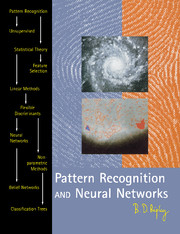Book contents
- Frontmatter
- Contents
- Preface
- Notation
- 1 Introduction and Examples
- 2 Statistical Decision Theory
- 3 Linear Discriminant Analysis
- 4 Flexible Discriminants
- 5 Feed-forward Neural Networks
- 6 Non-parametric Methods
- 7 Tree-structured Classifiers
- 8 Belief Networks
- 9 Unsupervised Methods
- 10 Finding Good Pattern Features
- A Statistical Sidelines
- Glossary
- References
- Author Index
- Subject Index
7 - Tree-structured Classifiers
Published online by Cambridge University Press: 05 August 2014
- Frontmatter
- Contents
- Preface
- Notation
- 1 Introduction and Examples
- 2 Statistical Decision Theory
- 3 Linear Discriminant Analysis
- 4 Flexible Discriminants
- 5 Feed-forward Neural Networks
- 6 Non-parametric Methods
- 7 Tree-structured Classifiers
- 8 Belief Networks
- 9 Unsupervised Methods
- 10 Finding Good Pattern Features
- A Statistical Sidelines
- Glossary
- References
- Author Index
- Subject Index
Summary
The use of tree-based methods for classification is relatively unfamiliar in both statistics and pattern recognition, yet they are widely used in some applications such as botany (Figure 7.1) and medical diagnosis as being extremely easy to comprehend (and hence have confidence in).
The automatic construction of decision trees dates from work in the social sciences by Morgan & Sonquist (1963) and Morgan & Messenger (1973). (Later work such as Doyle, 1973, and Doyle & Fenwick, 1975, commented on the pitfalls of such automated procedures.) In statistics Breiman et al. (1984) had a seminal influence both in bringing the work to the attention of statisticians and in proposing new algorithms for constructing trees. At around the same time decision tree induction was beginning to be used in the field of machine learning, which we review in Section 7.4, and in engineering (for example, Sethi & Sarvarayudu, 1982).
The terminology of trees is graphic, although conventionally trees such as Figure 7.2 are shown growing down the page. The root is the top node, and examples are passed down the tree, with decisions being made at each node until a terminal node or leaf is reached. Each non-terminal node contains a question on which a split is based. Each leaf contains the label of a classification. A subtree of T is a tree with root a node of T; it is a rooted subtree if its root is the root of T.
- Type
- Chapter
- Information
- Pattern Recognition and Neural Networks , pp. 213 - 242Publisher: Cambridge University PressPrint publication year: 1996
- 5
- Cited by



